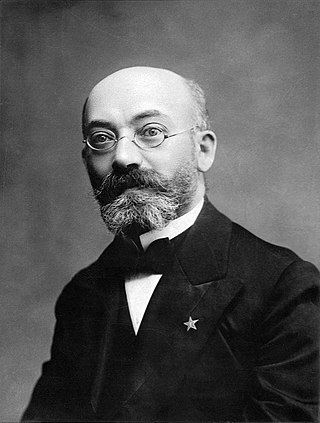
Esperanto is the world's most widely spoken constructed international auxiliary language. Created by the Warsaw-based ophthalmologist L. L. Zamenhof in 1887, it is intended to be a universal second language for international communication, or "the international language". Zamenhof first described the language in Dr. Esperanto's International Language, which he published under the pseudonym Doktoro Esperanto. Early adopters of the language liked the name Esperanto and soon used it to describe his language. The word esperanto translates into English as "one who hopes".

L. L. Zamenhof developed Esperanto in the 1870s and '80s. Unua Libro, the first print discussion of the language, appeared in 1887. The number of Esperanto speakers have increased gradually since then, without much support from governments and international organizations. Its use has, in some instances, been outlawed or otherwise suppressed.
Esperanto culture refers to the shared cultural experience of the Esperantujo, or Esperanto-speaking community. Despite being a constructed language, Esperanto has a history dating back to the late 19th century, and shared socio-cultural norms have developed among its speakers. Some of these can be traced back to the initial ideas of the language's creator, Ludwig Zamenhof, including the theory that a global second language would foster international communication. Others have developed over time, as the language has allowed different national and linguistic cultures to blend together. Some Esperanto speakers have also researched the language's ideologies.

The history of religion refers to the written record of human religious feelings, thoughts, and ideas. This period of religious history begins with the invention of writing about 5,200 years ago. The prehistory of religion involves the study of religious beliefs that existed prior to the advent of written records. One can also study comparative religious chronology through a timeline of religion. Writing played a major role in standardizing religious texts regardless of time or location, and making easier the memorization of prayers and divine rules.

L. L. Zamenhof was an ophthalmologist who lived for most of his life in Warsaw. He is best known as the creator of Esperanto, the most widely used constructed international auxiliary language.
Philosophy of religion is "the philosophical examination of the central themes and concepts involved in religious traditions". Philosophical discussions on such topics date from ancient times, and appear in the earliest known texts concerning philosophy. The field is related to many other branches of philosophy, including metaphysics, epistemology, logic and ethics.

In religion and theology, revelation is the disclosing of some form of truth or knowledge through communication with a deity (god) or other supernatural entity or entities.

Secular humanism is a philosophy, belief system or life stance that embraces human reason, logic, secular ethics, and philosophical naturalism, while specifically rejecting religious dogma, supernaturalism, and superstition as the basis of morality and decision making.
Universalism is the philosophical and theological concept that some ideas have universal application or applicability.
Proselytism is the policy of attempting to convert people's religious or political beliefs. Carrying out attempts to instill beliefs can be called proselytization.
The Baháʼí teachings represent a considerable number of theological, ethical, social, and spiritual ideas that were established in the Baháʼí Faith by Baháʼu'lláh, the founder of the religion, and clarified by its successive leaders: ʻAbdu'l-Bahá, Baháʼu'lláh's son, and Shoghi Effendi, ʻAbdu'l-Bahá's grandson. The teachings were written in various Baháʼí writings. The teachings of the Baháʼí Faith, combined with the authentic teachings of several past religions, are regarded by Baháʼís as revealed by God.
The Baháʼí Esperanto League (BEL) is the official organization of Baháʼís who are Esperantists. It was founded on 19 March 1973 with the approval of the Universal House of Justice.
The Baháʼí Faith teaches that the world should adopt an international auxiliary language, which people would use in addition to their mother tongue. The aim of this teaching is to improve communication and foster unity among peoples and nations. The Baháʼí teachings state, however, that the international auxiliary language should not suppress existing natural languages, and that the concept of unity in diversity must be applied to preserve cultural distinctions. The Baha'i principle of an International Auxiliary Language (IAL) represents a paradigm for establishing peaceful and reciprocal relations between the world's primary speech communities – while shielding them from undue linguistic pressures from the dominant speech community/communities.

Martha Louise Root was an American traveling teacher of the Baháʼí Faith in the early 20th century. From the declaration of her belief in 1909 until her death thirty years later, she went around the world four times. Shoghi Effendi, then head of the Baháʼí Faith, called her "the foremost travel teacher in the first Baháʼí Century", and named her a Hand of the Cause posthumously. Known for her numerous visits with heads of state and other public figures, of special importance was her interaction with Queen Marie of Romania, considered the first royal to accept Baháʼu'lláh.
The Bahá'í Faith teaches that there is a harmony or unity between science and religion, and that true science and true religion can never conflict. This principle is rooted in various statements in the Bahá'í scriptures. Some scholars have argued that ideas in the philosophy of science resonate with the Bahá'í approach. In addition, scholars have noted the Bahá'í view of interpreting religious scriptures symbolically rather than literally as conducive to harmony with scientific findings. The Bahá'í community and leadership have also applied their teachings on science and religion with the goal of the betterment of society, for instance by providing education and technology.

Lidia Zamenhof was a Jewish Polish writer, publisher, translator and the youngest daughter of Klara (Silbernik) and L. L. Zamenhof, the creator of Esperanto. She was an active promoter of Esperanto as well as of Homaranismo, a form of religious humanism first defined by her father.
The Baháʼí Faith in Ukraine began during the policy of oppression of religion in the former Soviet Union. Before that time, Ukraine, as part of the Russian Empire, would have had indirect contact with the Baháʼí Faith as far back as 1847. Following the Ukrainian diasporas, succeeding generations of ethnic Ukrainians became Baháʼís and some have interacted with Ukraine previous to development of the religion in the country which began rising as the region approached the Dissolution of the Soviet Union. As of around 2008 there were around a thousand known Baháʼís in Ukraine according to the community's national governing body, in 13 communities. International data reviewer Association of Religion Data Archives (ARDA) listed 227 Bahá'ís in 2010, and in 2021 a study found 12 Bahá'í communities in the country, placing it at among the smallest minority religions in the country. National observances of Bahá'í Holy Days had occurred in recent years.
The history of the Baháʼí Faith in Poland begins in the 1870s when Polish writer Walerian Jablonowski wrote several articles covering the religion's early history in Persia. There was a Polish-language translation of Paris Talks published in 1915. After becoming a Baháʼí in 1925, Poland's Lidia Zamenhof returned to Poland in 1938 as its first well-known Baháʼí. During the period of the Warsaw Pact, Poland adopted the Soviet policy of oppression of religion, so Poland's Baháʼí community, strictly adhering to its principle of obedience to legal government, abandoned its administration and properties. An analysis of publications before and during this period found that coverage by Soviet-based sources was basically hostile to the Baháʼí Faith while native Polish coverage was neutral or positive. By 1963, only Warsaw was recognized as having a Baháʼí community. Following the fall of communism in Poland because of the Revolutions of 1989, the Baháʼís in Poland began to initiate contact with each other and have meetings; the first of these arose in Kraków and Warsaw. In March 1991, the first Baháʼí Local Spiritual Assembly was re-elected in Warsaw. Poland's National Spiritual Assembly was elected in 1992. According to Baháʼí sources there were about 300 Baháʼís in Poland in 2006 and there have been several articles in Polish publications in 2008 covering the persecution of Baháʼís in Iran and Egypt. The Association of Religion Data Archives estimated that there were about 300 Baháʼís in 2005.

Louis-Christophe Zaleski-Zamenhof was a Polish-born French civil and marine engineer, specializing in the design of structural steel and concrete construction. He was a grandson of the Polish Jewish L. L. Zamenhof, the inventor of the international auxiliary language Esperanto. From the 1960s until his death, Zaleski-Zamenhof lived in France.








